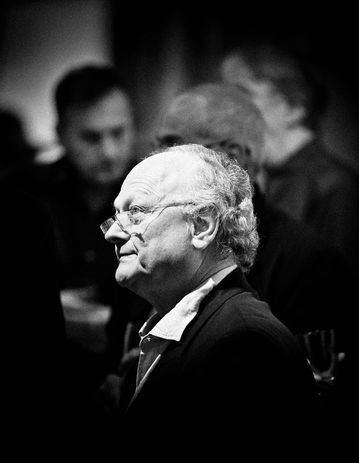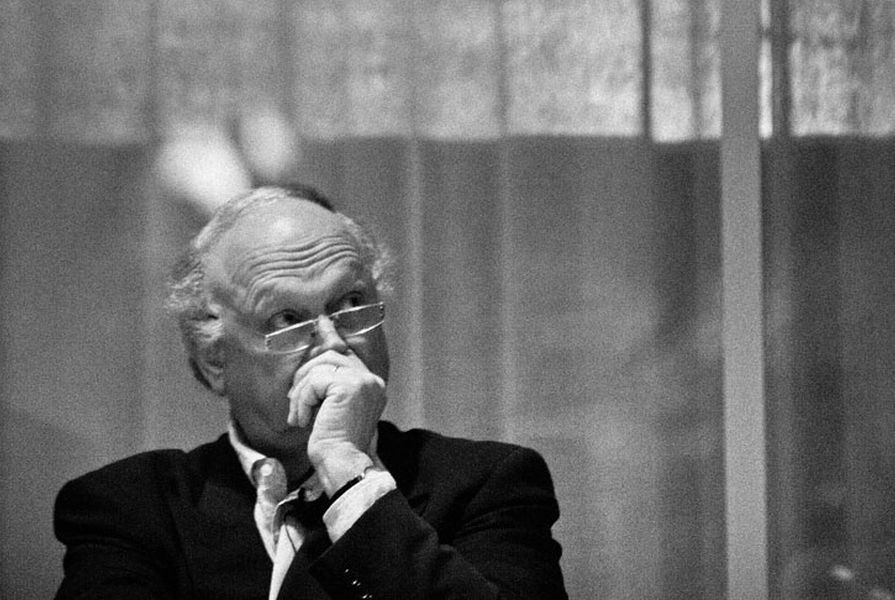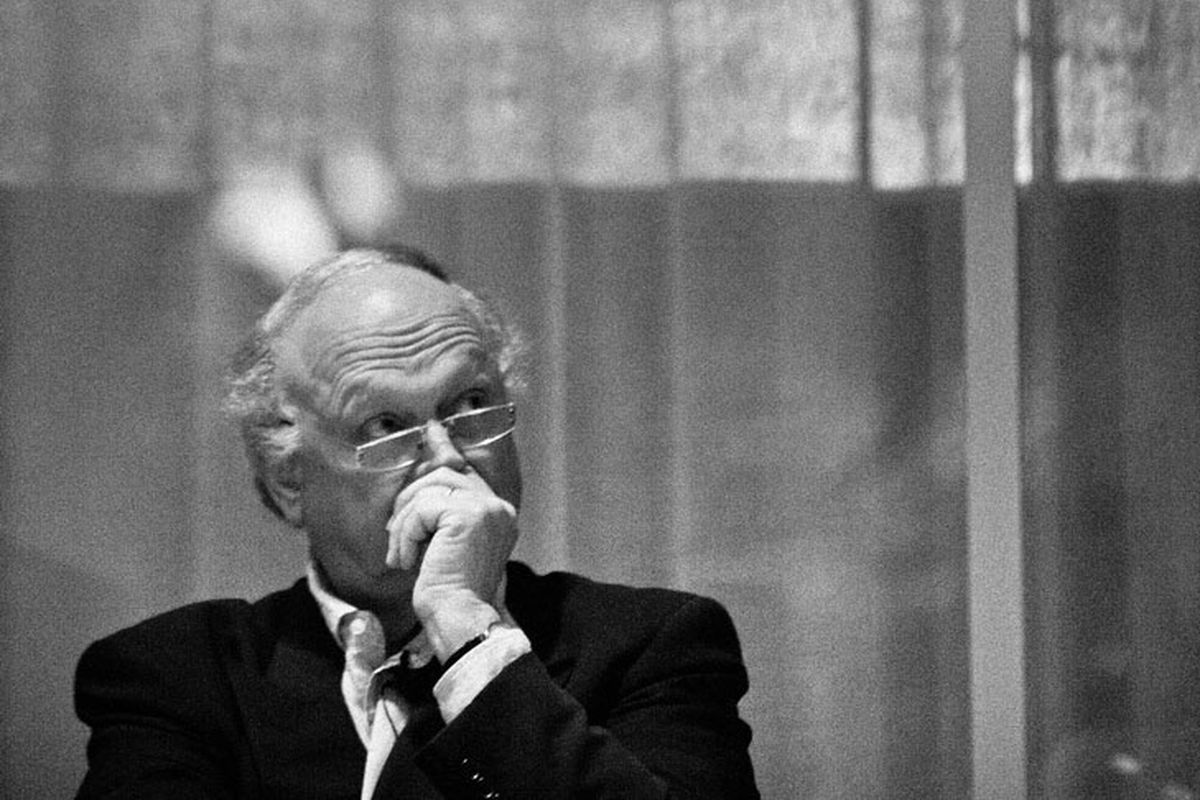Marcus Trimble You started your office after a number of years working for a series of established architects including Neville Gruzman and Ancher Mortlock & Woolley. It is always a tough gig setting up an architecture office, but we like to look back with rose-coloured glasses. I am curious to know if it was as tough then as it is now, and what the economic climate was like at the time?

Guest of honour, Glenn Murcutt, at Dedece, December 2010.
Image: Brett Boardman
Glenn Murcutt Terrible – the country was in a recession. But our next-door neighbour, Russell Slade, a director of Polymer Products and other major companies, would drive me into town at least twice a week. He was really very important to me; he said, “I love recessions – they are like a flood that cleans the system out and once it’s clean you are ready for when things are good again. The plants start growing and the whole river ecology starts to get back to its proper thing, same as in business.” So I was not so frightened to go into practice. I had one job which was a bit of a disaster for me, then I had nothing else for about nine months, but what I did do was get every company that I could think of in the building industry and ask them to send me catalogues. It occurred to me that there was another way to look at detail with industrial components and that was to make a [link] between these components and what you are doing. All of a sudden tomato house glazing came in, Aluminex glazing bars and louvres came in – all these industrial things that you put in factories. I found a way in which they might be able to be used in architecture.
Because I had little work, my brother asked me to design his house instead of buying a project home, and then Laurie Short came and I did his house and both buildings won awards. And then Marie Short came to me for the Crescent Head House, then a whole series of things started to happen. In 1972, an alteration on my house in Wunda won for me a trip around the world; real estate agents Gray and Mulroney together with the Royal Australian Institute of Architects had an award for alterations and additions with the aim to show how a modern addition can be made without replicating a 1912 Federation-style bungalow. This gave me $1,000 for a trip to go around and visit the work of the architects from the Americas and Europe who had achieved wonderful results through alterations and additions, like Maison de Verre in Paris. That was the only obligation – so in 1973 I went away for four months. Absolutely amazing.
Another aspect of starting in practice was that three days after I left the office I had worked in for five years I was invited to teach by Sydney University, so I went into practice in November 1969 and I was teaching in March the following year; [I was] combining work and teaching.
MT Along with teaching, how have you mentored other architects through your practice?
GM It is very rare [that I have employees]. What I generally do is make an association on the project where we share equal collaboration. For example, Reg Lark and Wendy [Lewin] and I were in collaboration for the Arthur and Yvonne Boyd Education Centre. I am collaborating with Hakan Elevli in Melbourne on the Altona mosque. I am collaborating with Wendy on the Lightning Ridge Australian Opal Centre [and] with a number of other architects like Troppo, who I collaborated with on the [Bowali Visitor Centre and Headquarters at Kakadu].
Some of the students I have taught – Paul Pholeros, Alec Tzannes, Wendy Lewin, Stephen Lesuik – there are so many that are out there now doing the sort of things I was articulating back in the 1970s. They are not all doing “Murcutt” buildings because that was my last aim. The aim is to understand underlying principles. To understand the principles is like a toolset.
MT As an architect that has focused on residential architecture, I am interested in how you see the current situation of real estate as entertainment or hobby, and the resulting commodification of architecture. One of the upsides of this is that people are now more literate in terms of reading plans, as a result of the extensive real estate listings for every property. How have residential clients changed over the years?
GM In the 1950s when I did my education and 1961 when I finished, there was a lot of land still vacant in the Northern Beaches [and] southern beaches that were within ten kilometres of the coast. It was at a time when one salary was able to buy a block of land. This was before society changed in the 1970s, when society saw that the man [would be the breadwinner] and the woman [would raise] the children – it all changed and very quickly. The economic base of things changed – if only one breadwinner can sustain a family the economy is set to what that breadwinner can afford. Things came in stages; there wasn’t this idea that one could borrow ninety percent of the value of the property, including the land and the house you bought. One had to save.
Of course, then came the project house, which was another step up, and at this time it became acceptable for both men and women to become breadwinners and bring income that allowed for the block of land and the house – the complete package. The project house became achievable and buyers became interested in design. They were educated by the house and became visually literate [because] there were so many good quality project houses. For example, Pettit+Sevitt, Habitat, Program, Merchant Builders – they were all here and they were all excellent works. Ken Woolley, Harry Seidler, Dysart, Gunn from Melbourne, Terry Dorrough – they designed good houses. The weekend was taken up with hundreds of people visiting project houses. There was not just the last difficult sites to build on as there was enough land [on which] one could construct, say, the “low line,” “split level” and many others – all very cleverly done.
MTI guess the sense now is that in the procuring of public work, the criteria for selection is the lowest fee and the least amount of risk that a practice may represent to the project. Do you feel that this is a new development, and how do you see it as affecting the profession?
GM People seem most interested in purchase power. So hence we go full circle as to why clients select an architect based on the lowest fee rather than the quality of the work. And frankly the old adage “you get what you pay for” still stands.
MT You pay peanuts you get monkeys.
GM Yes. I was working with a client from a university in Victoria and he said to me: “We are no different to developers – we select architects based on the lowest fee and fifteen years later we are spending more in repair work on those buildings than we paid for the cost of the buildings in the beginning. Had we gone to an architect of choice and got quality work we would have been far better off economically in the long term.” That is what we have lost. And then I think it would have been in the 1980s. [There were some] fairly important discussions [had at that time] about the role of the architect; [we thought then that we need not] carry a project through to reality and that perhaps the site inspection role could be undertaken by a professional other than an architect.
MT So this was the rise of the project manager?
GM This was the rise of the project manager. We abrogated our responsibility because as architects we were project managers, we were trained to be project managers, we took a building from beginning to the end. All of a sudden we decided we could reduce our fee and let another person come in there, but we did not think it through. Because the other person let in was essentially visually illiterate and made decisions [based] on dollars and cents, which did not make sense. We lost a vital part [of what makes a] building “sing.”
MT A diminishment of the role of the architect in the mind of the client and the mind of the authority.
GM Sure. The architect is the one who sits down and visualizes this and does it. The first thing a client asks today is “give me a picture or perspective and what it looks like.” I mean, what nonsense is that? When we first started the Boyd centre that is one of the first things they wanted to know [when they went] about selecting the architect – they just wanted to know what it was going to look like. I wrote them a letter and [explained that that is] not the way we do things – architecture is about understanding a client’s brief. That changes to the brief will occur on the way through and a good client understands that. Now when I said “a good client understands that,” I think ears pricked up and [they thought], “are we good clients?” So the role of the architect has changed enormously – we listen and we can easily be compromised without fighting. Yet, I hate fighting. I will not do a job unless I have the opportunity to take it fully through to completion.
MT Another aspect of this is that the profession is broadening its scope and becoming less focused on strictly the design of buildings. Your practice is closely tied to the specific act of building design as that is your passion. What do you think of architecture shifting to fulfilling a more strategic role in city-making?
GM Well, it is no longer architecture, is it? Architecture is quite clear – it is about designing buildings, objects, almost anything, like a car … the most important point of architecture is design. There are other things that support it [but] designing is a mental activity, designing is about the mind. It is about understanding light, space, structure, order – all these things. There are people who are fantastic on transport systems, there are people who are fantastic at understanding the fabric of a city and what the mix might be. We have such naive planning laws. The greatest cities [are a] mix, where a market might be in the middle of housing, and so on. Diversity of activities.
MT I always think of it as a conglomerate rock that is pushed together under pressure.
GM It is like a conglomerate rock … the greatest [cities] are developed not on regulations but in an almost laissez faire [way]. Regulations are important but to have a flat regulation – “this is all residential and that is where the commercial will go” – I think is nonsense. The Spanish gave that away forty or fifty years ago. I chaired the jury for the Peace Park at Gallipoli Peninsula and the Turks were at about the same level as we were; that is, there was a planning strategy and they had diagrams of coloured areas – “this will be where commercial will be, this will be the residential, this will be how this works.” I remember Ignasi de Solà-Morales – he was an amazing guy; he was fantastic – he said, “I do not understand you – we gave away this sort of planning years ago. This is what it is about – mixing things up. These are the sorts of solutions we should be looking at.” And he was right. That is the problem – we have to be more flexible. We are too much of the British sort of planning strategy. Laws and number crunching neatly packaged. I recall working in London in the early 60s and the Royal Institute of British Archtects (RIBA) put out the dictum: FLEOS + VAL = Design (Function, Logical, Economic, Optimum, Solution + Visual Acceptability Loading).
The other aspect is the legal profession. If we are talking about risk, then risk is about the legal profession. Ultimately if you develop a proposal and it does not work out, well, then you have a bloody curly-headed lawyer on your tail.
This is a big issue. If you want to make progress you have to take a calculated risk. I have done that all my career, but I cut my teeth on alterations and additions – at one stage I had thirty-three alterations and additions. In my first ten years of practice I [only] did three new houses. I became known as the king of alterations and additions. If you wanted a good alteration or addition, go to Murcutt. Do you know what I did? In every one I had one little experiment – one little thing to build up a vocabulary of risks. [If it was only a] little thing and it did not work out it didn’t matter so much. So I used my ten years of alterations and additions as the method of research.
Now, the other thing that I was taught by my father [was to] never be in a rush to be a success, and if it should ever come handle it with kid gloves.
So we go back to the legal profession. They provide the platform for us to not take risk, because we know if something goes wrong we are vulnerable. Why is our professional indemnity so expensive? I think it is incredibly expensive and I understand it is exercised to protect one in four insured each year. One in four in our profession – that is terrible.
I have notified my insurers probably four times in forty-two years that there may be a case – mainly when builders have walked off the site and where there is no way that one can finish the project for the money that is left in the contract. One is always going to have to spend another 10 or 15 percent extra over the original contract sum to complete. It makes us entirely vulnerable; the law does not take that into consideration, so one cannot afford to have a builder walk off the site. It is too dangerous. Thank goodness, I’ve never been sued, I have not even been threatened – perhaps I’m taking an awful risk saying that!
MT You have been lucky so far.
GM But I have taken the opportunity when I have felt that someone might try to notify my insurer. I have been very careful about that, so the insurance company has done very well out of me to date!
MT We have to have it.
GM Yes, we have to have it, but is that not a manifestation of the dreadful state that we are in?
MT When did that start happening?
GM It was really starting to be thought about in the late 1960s. Bigger offices had been carrying insurance but smaller practices could not afford to carry insurance. I did not have professional indemnity for my first eight or nine years in practice. I did not think it was that necessary.
Clients were all nice – I did my best for them. It is the legal profession that is really the challenging profession. It is a really difficult time for architects. Let me say this: if one is working with a board, there is a much greater risk of getting sued. If one is working with an individual client you can say “you are as responsible to me as I am equally to you.” You can negotiate and work through any difficulties that may arise more easily and not resort to court action.
MT Yes, a board is another matter – it is indifferent and detached.
GM Yes, detached. Go back to your earlier statement – it generally only looks at money and time is also seen as money; it is part of our culture. I remember in the 1960s, 1970s and 1980s dinner tables were only talking about capital gain, trading houses, real estate profits … it was a big, big topic. Australians suddenly realized that we do expect a very good income and that our living standards are very high. It is [incorrect] that our living standards are the greatest – living standard is consumption based and therein lies the idea that money becomes the ultimate thing – for consumption! And little has changed. We are short term, short thinking and short span – same in our politics. Our politics are there generally for the moment; they tend to think to the next election and not about thirty, forty or a hundred years ahead. Not unlike “how can I turn this building over to get myself 10 percent profit? How can I get an architect to do enough work on this property to get it sold quickly, make me 14 percent profit?”
MT How have you seen the profession change with regard to how architects relate to other architects?
GM Amongst architects there was such a design camaraderie in the 1950s. Firstly there was enough work around to keep everybody going. Today some offices are so big and they need a lot of work to keep them going. Practising architects have to be so competitive against other architects, particularly in the “big end” of town. Competition is not the only way to go about receiving a commission – the Aboriginal people survived by cooperation, not through competition, as opposed to the Darwinian survival of the fittest.
Competition does not necessarily always produce the best. It can do in some things but not necessarily so in procuring a project. But in the 1950s we had lots of architects that were so much part of one another and were part of a real profession, not isolated individuals. I recall the relationships between Ian Mackay, Bruce Rickard, Harry Howard, Neville Gruzman, Bill Lucas and others. They critiqued one another’s work, had discussions on built work, undertook planning studies and projects together at the University of Sydney. They did competitions of ideas together, they were a force in Sydney and respected one another enormously. They supported one another, they did not take commissions from one another.
MT Yes, there are stories of similar practices locally undercutting and manoeuvring their way into other office’s projects.
GM There are those who will do anything; I have experienced it first hand, and you can quote me. Not mentioning which job, but it was a project in collaboration. We were well underway on an important project to us, four months into it, when a well-known city architect rang our client suggesting that we could be replaced, and that this practice could do the design component without cost and then do the contract documents and site inspections for a much-reduced fee. My client contacted me and asked me “what sort of a profession are we in with that sort of thing taking place?” The project remained and it went well. When I received the Pritzker Prize I got a letter that offered congratulations, but with the barb being, “Some of us have to take on the tough things in practice like designing commercial work.” Right – what sort of a congratulatory letter is that? All it implies is a “grab-all-if-you-can-get-it” attitude. Large practices do require large or smaller significant projects and if work is scarce, problems emerge.
MT Yes, that type of work relies on a generous profession as well. It is a difficult thing finding those collaborations.
GM I’ve greatly enjoyed collaborating with those I greatly respect and generosity by each is not ever discussed, it is understood. Collaborations are important and each of us is able to contribute equally on every stage of a project without having to engage staff and that has been wonderful – and no need to “grab all of it if you can get it.”
This conversation was part of a dinner in Glenn Murcutt’s honour hosted in Decekber 20120 by Dedece, Vola and Architecture Australia.
Source

People
Published online: 14 May 2012
Words:
Marcus Trimble
Images:
Brett Boardman
Issue
Architecture Australia, January 2012
















